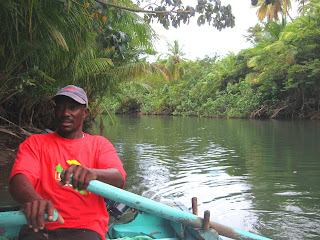Indian River
Cricket
I was eating at the Purple Turtle, a beach restaurant, and listening to the cricket match. I asked a few questions of the waitress, who was obviously a big cricket fan, and she said that she and her friend were going down to Roseau tomorrow, and I should join them. I thought about it for a couple of minutes, and said "I cant wait!"At this point, I need to back up - there are only a few test matches a year in the West Indies, and because Dominica is such a huge cricket country (and they have a beautiful new stadium), one of them is played here. This is world class cricket - the West Indies team is one of ten full members recognized by the ICC, and the only one that consists of more than one country (15, actually). A "test match" is traditional cricket, which can take up to five days to play. Basically, and this is for my American friends, it's like a two inning baseball game, but there are ten outs in each inning. A couple more things - there are only two "bases", not four, and a team mate is always on the other one, so that when you run, you trade places. There are no balls and strikes, and if you hit the ball, you don't have to run. There are several ways to make an out, but the two main ones are by letting a bowled ball (a pitch) hit the wicket, which consists of three stakes behind the batsman, or batting a ball which is caught in the air by a fielder. Now, the bowler (pitcher) doesn't throw from a mound - he gets about a 50 foot run towards the batsman before he delivers the ball. You'd be amazed at how long these batters can defend the wicket, while occasionally getting a hit, without making an out.
But wait, before we can get to the stadium, we need to take to bus from Portsmouth, in the north, to Roseau, the capital. An island "bus" is actually a mid sized van. The drivers fill them up before they leave, but there is "always room for more". We stop to pick up a couple more people, and it looks like they won't fit, but the passengers just get out and do what we used to call a "Chinese fire drill", and arrange themselves so that the girths of the passengers are equally distributed in the bench seats. Just as we are pulling away, a Mom and her baby come up - of course there's room! Another fire drill and seventeen people are snugly settled in the non-air conditioned van.
The upper photo shows Shane Shillingford the hometown hero from Dominica, in the process of bowling (left). He is a spin bowler, so when the ball hits the ground in front of the batsman, it does strange things, causing the batter to tend to tick the ball off or pop up weakly. (Oh yeah, I forgot to mention that you can bounce the pitches in.) In the close up below, you can see that there are two fielders right next to the Zimbabwe batsman. So, imagine taking the first and third basemen and having them play all the way down the lines, ten feet from the batter. That's what's going on here - except the batter isn't bunting - he's swinging away! "Coach, you want me to do WHAT?!?"
Fort Shirley and Prince Rupert Bay
Dominica was the first island sighted on Columbus' second voyage. Also, the three ships bound for what would become Jamestown stopped here in Prince Rupert Bay in 1607. (Yes, that's very far out of their way - at that time, most of the ships still took the trade wind route.) And, in 1952, the first woman to sail solo across the Atlantic made port here after a very difficult passage from the Canary Islands in her 23 foot boat. Her name was Ann Davison, quite an interesting woman: http://www.wavetrain.net/lit-bits/336-ann-davison-transatlantic-on-felicity-annThese are the guns the privateers used to sink and then plunder cruise ships.
On a more serious note, this is worthwhile reading.
















No comments:
Post a Comment